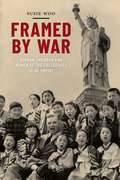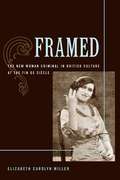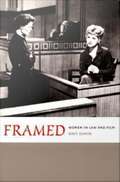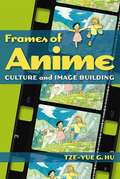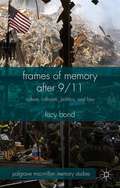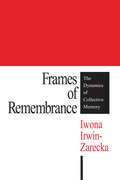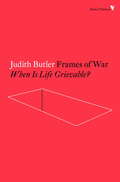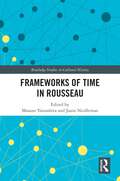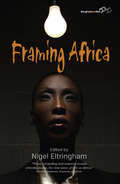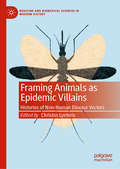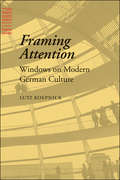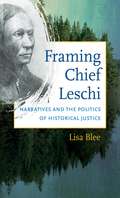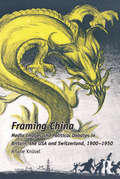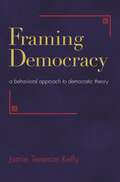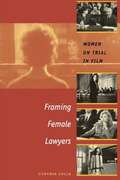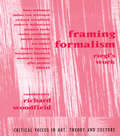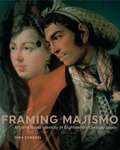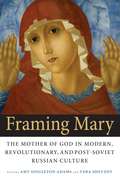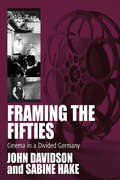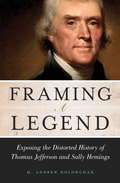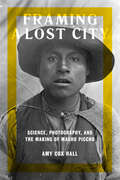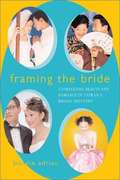- Table View
- List View
Framed by War: Korean Children and Women at the Crossroads of US Empire (Nation of Nations #30)
by Susie WooAn intimate portrait of the postwar lives of Korean children and women Korean children and women are the forgotten population of a forgotten war. Yet during and after the Korean War, they were central to the projection of US military, cultural, and political dominance. Framed by War examines how the Korean orphan, GI baby, adoptee, birth mother, prostitute, and bride emerged at the heart of empire. Strained embodiments of war, they brought Americans into Korea and Koreans into America in ways that defined, and at times defied, US empire in the Pacific. What unfolded in Korea set the stage for US postwar power in the second half of the twentieth century and into the twenty-first. American destruction and humanitarianism, violence and care played out upon the bodies of Korean children and women. Framed by War traces the arc of intimate relations that served as these foundations. To suture a fragmented past, Susie Woo looks to US and South Korean government documents and military correspondence; US aid organization records; Korean orphanage registers; US and South Korean newspapers and magazines; and photographs, interviews, films, and performances. Integrating history with visual and cultural analysis, Woo chronicles how Americans went from knowing very little about Koreans to making them family, and how Korean children and women who did not choose war found ways to navigate its aftermath in South Korea, the United States, and spaces in between.
Framed: The New Woman Criminal in British Culture at the Fin de Siecle
by Elizabeth Carolyn MillerFramed uses fin de siècle British crime narrative to pose a highly interesting question: why do female criminal characters tend to be alluring and appealing while fictional male criminals of the era are unsympathetic or even grotesque? In this elegantly argued study, Elizabeth Carolyn Miller addresses this question, examining popular literary and cinematic culture from roughly 1880 to 1914 to shed light on an otherwise overlooked social and cultural type: the conspicuously glamorous New Woman criminal. In so doing, she breaks with the many Foucauldian studies of crime to emphasize the genuinely subversive aspects of these popular female figures. Drawing on a rich body of archival material, Miller argues that the New Woman Criminal exploited iconic elements of late nineteenth- and early twentieth-century commodity culture, including cosmetics and clothing, to fashion an illicit identity that enabled her to subvert legal authority in both the public and the private spheres.
Framed: Women in Law and Film
by Orit KamirSome women attack and harm men who abuse them. Social norms, law, and films all participate in framing these occurrences, guiding us in understanding and judging them. How do social, legal, and cinematic conventions and mechanisms combine to lead us to condemn these women or exonerate them? What is it, exactly, that they teach us to find such women guilty or innocent of, and how do they do so? Through innovative readings of a dozen movies made between 1928 and 2001 in Europe, Japan, and the United States, Orit Kamir shows that in representing "gender crimes," feature films have constructed a cinematic jurisprudence, training audiences worldwide in patterns of judgment of women (and men) in such situations. Offering a novel formulation of the emerging field of law and film, Kamir combines basic legal concepts--murder, rape, provocation, insanity, and self-defense--with narratology, social science methodologies, and film studies. Framed not only offers a unique study of law and film but also points toward new directions in feminist thought. Shedding light on central feminist themes such as victimization and agency, multiculturalism, and postmodernism, Kamir outlines a feminist cinematic legal critique, a perspective from which to evaluate the "cinematic legalism" that indoctrinates and disciplines audiences around the world. Bringing an original perspective to feminist analysis, she demonstrates that the distinction between honor and dignity has crucial implications for how societies construct women, their social status, and their legal rights. In Framed, she outlines a dignity-oriented, honor-sensitive feminist approach to law and film.
Frames of Anime
by Tze-yue G. Huapanese anime has long fascinated the world, and its mythical heroes and dazzling colors increasingly influence popular culture genres in the West. Tze-yue G. Hu analyzes the 'language-medium' of this remarkable expressive platform and its many socio-cultural dimensions from a distinctly Asian frame of reference, tracing its layers of concentric radiation from Japan throughout Asia. Her work, rooted in archival investigations, interviews with animators and producers in Japan as well as other Asian animation studios, and interdisciplinary research in linguistics and performance theory, shows how dialectical aspects of anime are linked to Japan's unique experience of modernity and its cultural associations in Asia, including its reliance on low-wage outsourcing. Her study also provides English readers with insights on numerous Japanese secondary sources, as well as a number of original illustrations offered by animators and producers she interviewed.
Frames of Memory after 9/11
by Lucy BondFrames of Memory makes an important intervention into the emerging body of scholarship surrounding the culture and politics of the post-9/11 world. Bond provides a sweeping analysis of American memorial culture after 11 September, examining the ways in which diverse modes of commemoration, from Acts of Congress to museum exhibits, the military commissions at Guantanamo Bay to the corpus of 9/11 trauma fiction, have adhered to delimiting templates of remembrance that present an artificial impression of a unified American response to the attacks. In so doing, the book poses a series of urgent questions about the ethical and political factors at stake in the work of memory, asking why, and with what consequences, commemoration becomes an ideological endeavour; in what ways the academic discipline of memory studies influences contemporary memorial practice, and vice versa; what it means to seek justice for the dead; and how we might open the exceptionalist and exclusionary culture of memory surrounding 9/11 to a more diverse, globally oriented engagement with the recent past. "
Frames of Remembrance: The Dynamics of Collective Memory
by Iwona Irwin-ZareckaWhat is the symbolic impact of the Vietnam War Memorial? How does television change our engagement with the past? Can the efforts to wipe out Communist legacies succeed? Should victims of the Holocaust be celebrated as heroes or as martyrs? These questions have a great deal in common, yet they are typically asked separately by people working in distinct research areas in different disciplines. Frames of Remembrance shares ideas and concerns across such divides.
Frames of War: When Is Life Grievable? (Radical Thinkers)
by Judith ButlerIn Frames of War, Judith Butler explores the media's portrayal of state violence, a process integral to the way in which the West wages modern war. This portrayal has saturated our understanding of human life, and has led to the exploitation and abandonment of whole peoples, who are cast as existential threats rather than as living populations in need of protection. These people are framed as already lost, to imprisonment, unemployment and starvation, and can easily be dismissed. In the twisted logic that rationalizes their deaths, the loss of such populations is deemed necessary to protect the lives of 'the living.' This disparity, Butler argues, has profound implications for why and when we feel horror, outrage, guilt, loss and righteous indifference, both in the context of war and, increasingly, everyday life.This book discerns the resistance to the frames of war in the context of the images from Abu Ghraib, the poetry from Guantanamo, recent European policy on immigration and Islam, and debates on normativity and non-violence. In this urgent response to ever more dominant methods of coercion, violence and racism, Butler calls for a re-conceptualization of the Left, one that brokers cultural difference and cultivates resistance to the illegitimate and arbitrary effects of state violence and its vicissitudes.
Frameworks of Time in Rousseau (Routledge Studies in Cultural History)
by Jason Neidleman Masano YamashitaFrameworks of Time in Rousseau explores the ways in which Jean-Jacques Rousseau envisaged time as a diagnostic tool for understanding the state of society and the predicaments of modernity. Central to his conceptualization of both nature and history, time also plays a unique role in Rousseau’s literary and aesthetic explorations of selfhood and affect. This book brings into dialogue specialists from education, political theory, literature, and cultural studies with the aim of underscoring Rousseau’s contributions to themes that preoccupy us today such as the appreciation of slow time, the uncounted time of women’s lives, and temporal challenges related to politics and the economy.
Framing Africa
by Nigel EltringhamThe first decade of the 21st century has seen a proliferation of North American and European films that focus on African politics and society. While once the continent was the setting for narratives of heroic ascendancy over self (The African Queen, 1951; The Snows of Kilimanjaro, 1952), military odds (Zulu, 1964; Khartoum, 1966) and nature (Mogambo, 1953; Hatari!,1962; Born Free, 1966; The Last Safari, 1967), this new wave of films portrays a continent blighted by transnational corruption (The Constant Gardener, 2005), genocide (Hotel Rwanda, 2004; Shooting Dogs, 2006), 'failed states' (Black Hawk Down, 2001), illicit transnational commerce (Blood Diamond, 2006) and the unfulfilled promises of decolonization (The Last King of Scotland, 2006). Conversely, where once Apartheid South Africa was a brutal foil for the romance of East Africa (Cry Freedom, 1987; A Dry White Season, 1989), South Africa now serves as a redeemed contrast to the rest of the continent (Red Dust, 2004; Invictus, 2009). Writing from the perspective of long-term engagement with the contexts in which the films are set, anthropologists and historians reflect on these films and assess the contemporary place Africa holds in the North American and European cinematic imagination.
Framing Animals as Epidemic Villains: Histories of Non-Human Disease Vectors (Medicine and Biomedical Sciences in Modern History)
by Christos LynterisThis book takes a historical and anthropological approach to understanding how non-human hosts and vectors of diseases are understood, at a time when emerging infectious diseases are one of the central concerns of global health. The volume critically examines the ways in which animals have come to be framed as ‘epidemic villains’ since the turn of the nineteenth century. Providing epistemological and social histories of non-human epidemic blame, as well as ethnographic perspectives on its recent manifestations, the essays explore this cornerstone of modern epidemiology and public health alongside its continuing importance in today’s world. Covering diverse regions, the book argues that framing animals as spreaders and reservoirs of infectious diseases – from plague to rabies to Ebola – is an integral aspect not only to scientific breakthroughs but also to the ideological and biopolitical apparatus of modern medicine. As the first book to consider the impact of the image of non-human disease hosts and vectors on medicine and public health, it offers a major contribution to our understanding of human-animal interaction under the shadow of global epidemic threat.
Framing Attention: Windows on Modern German Culture (Parallax: Re-visions of Culture and Society)
by Lutz KoepnickIn Framing Attention, Lutz Koepnick explores different concepts of the window—in both a literal and a figurative sense—as manifested in various visual forms in German culture from the nineteenth century to the present. He offers a new interpretation of how evolving ways of seeing have characterized and defined modernity.Koepnick examines the role and representation of window frames in modern German culture—in painting, photography, architecture, and literature, on the stage and in public transportation systems, on the film screen and on television. He presents such frames as interfaces that negotiate competing visions of past and present, body and community, attentiveness and distraction. From Adolph Menzel's window paintings of the 1840s to Nam June Paik's experiments with television screens, from Richard Wagner's retooling of the proscenium stage to Adolf Hitler's use of a window as a means of political self-promotion, Framing Attention offers a theoretically incisive understanding of how windows shape and reframe the way we see the world around us and our place within it.
Framing Canadian Federalism
by Dimitry Anastakis Penny BrydenFraming Canadian Federalism assembles an impressive range of scholars to consider many important issues that relate to federalism and the history of Canada's legal, political, and social evolution. Covering themes that include the Supreme Court of Canada, changing policies towards human rights, First Nations, as well as the legendary battles between Mitchell Hepburn and W.L. Mackenzie King, this collection illustrates the central role that federalism continues to play in the Canadian polity. Editors Dimitry Anastakis and P.E. Bryden and the volume's contributors, demonstrate the pervasive effects that federalism has on Canadian politics, economics, culture, and history, and provide a detailed framework in which to understand contemporary federalism. Written in honour of John T. Saywell's half-century of accomplished and influential scholarly work and teaching, Framing Canadian Federalism is a timely and fitting tribute to one of the discipline's foremost thinkers.
Framing Chief Leschi
by Lisa BleeIn 1855 in the South Puget Sound, war broke out between Washington settlers and Nisqually Indians. A party of militiamen traveling through Nisqually country was ambushed, and two men were shot from behind and fatally wounded. After the war, Chief Leschi, a Nisqually leader, was found guilty of murder by a jury of settlers and hanged in the territory's first judicial execution. But some 150 years later, in 2004, the Historical Court of Justice, a symbolic tribunal that convened in a Tacoma museum, reexamined Leschi's murder conviction and posthumously exonerated him. In Framing Chief Leschi, Lisa Blee uses this fascinating case to uncover the powerful, lasting implications of the United States' colonial past.Though the Historical Court's verdict was celebrated by Nisqually people and many non-Indian citizens of Washington, Blee argues that the proceedings masked fundamental limits on justice for Indigenous people seeking self-determination. Underscoring critical questions about history and memory, Framing Chief Leschi challenges readers to consider whether liberal legal structures can accommodate competing narratives and account for the legacies of colonialism to promote social justice today.
Framing China: Media Images and Political Debates in Britain, the USA and Switzerland, 1900-1950
by Ariane KnüselFraming China sheds new light on Western relations with and perceptions of China in the first half of the twentieth century. In this ground-breaking book, Ariane Knüsel examines how China was portrayed in political debates and the media in Britain, the USA and Switzerland between 1900 and 1950. By focusing on the political, economic, cultural and social context that led to the construction of the particular images of China in each country, the author demonstrates that national interests, anxieties and issues influenced the way China was framed and resulted in different portrayals of China in each country. The author’s meticulous analysis of a vast amount of newspaper and magazine articles, commentaries, editorials, cartoons and newsreels that have previously not been studied before also focuses on the transnational circulation of images of China. While previous publications have dealt with the occurrence of the Yellow Peril and Red Menace in particular countries, Framing China reveals that these images were interpreted differently in every nation because they both reflected and contributed to the discursive construction of nationhood in each country and were influenced by domestic issues, cultural values, pre-existing stereotypes, pressure groups and geopolitical aspirations.
Framing Democracy: A Behavioral Approach to Democratic Theory
by Jamie Terence KellyThe past thirty years have seen a surge of empirical research into political decision making and the influence of framing effects--the phenomenon that occurs when different but equivalent presentations of a decision problem elicit different judgments or preferences. During the same period, political philosophers have become increasingly interested in democratic theory, particularly in deliberative theories of democracy. Unfortunately, the empirical and philosophical studies of democracy have largely proceeded in isolation from each other. As a result, philosophical treatments of democracy have overlooked recent developments in psychology, while the empirical study of framing effects has ignored much contemporary work in political philosophy. In Framing Democracy, Jamie Terence Kelly bridges this divide by explaining the relevance of framing effects for normative theories of democracy. Employing a behavioral approach, Kelly argues for rejecting the rational actor model of decision making and replacing it with an understanding of choice imported from psychology and social science. After surveying the wide array of theories that go under the name of democratic theory, he argues that a behavioral approach enables a focus on three important concerns: moral reasons for endorsing democracy, feasibility considerations governing particular theories, and implications for institutional design. Finally, Kelly assesses a number of methods for addressing framing effects, including proposals to increase the amount of political speech, mechanisms designed to insulate democratic outcomes from flawed decision making, and programs of public education. The first book to develop a behavioral theory of democracy, Framing Democracy has important insights for democratic theory, the social scientific understanding of political decision making, economics, and legal theory.
Framing Female Lawyers: Women on Trial in Film
by Cynthia LuciaAs real women increasingly entered the professions from the 1970s onward, their cinematic counterparts followed suit. Women lawyers, in particular, were the protagonists of many Hollywood films of the Reagan-Bush era, serving as a kind of shorthand reference any time a script needed a powerful career woman. Yet a close viewing of these films reveals contradictions and anxieties that belie the films' apparent acceptance of women's professional roles. In film after film, the woman lawyer herself effectively ends up "on trial" for violating norms of femininity and patriarchal authority.<P><P>In this book, Cynthia Lucia offers a sustained analysis of women lawyer films as a genre and as a site where other genres including film noir, maternal melodrama, thrillers, action romance, and romantic comedy intersect. She traces Hollywood representations of female lawyers through close readings of films from the 1949 Adam's Rib through films of the 1980s and 1990s, including Jagged Edge, The Accused, and The Client, among others. She also examines several key male lawyer films and two independent films, Lizzie Borden's Love Crimes and Susan Streitfeld's Female Perversions. Lucia convincingly demonstrates that making movies about women lawyers and the law provides unusually fertile ground for exploring patriarchy in crisis. This, she argues, is the cultural stimulus that prompts filmmakers to create stories about powerful women that simultaneously question and undermine women's right to wield authority.
Framing Formalism: Riegl's Work (Critical Voices in Art, Theory and Culture)
by Richard WoodfieldFirst Published in 2001. Routledge is an imprint of Taylor & Francis, an informa company.
Framing Majismo: Art and Royal Identity in Eighteenth-Century Spain
by Tara ZanardiMajismo, a cultural phenomenon that embodied the popular aesthetic in Spain from the second half of the eighteenth century, served as a vehicle to “regain” Spanish heritage. As expressed in visual representations of popular types participating in traditional customs and wearing garments viewed as historically Spanish, majismo conferred on Spanish “citizens” the pictorial ideal of a shared national character.In Framing Majismo, Tara Zanardi explores nobles’ fascination with and appropriation of the practices and types associated with majismo, as well as how this connection cultivated the formation of an elite Spanish identity in the late 1700s and aided the Bourbons’ objective to fashion themselves as the legitimate rulers of Spain. In particular, the book considers artistic and literary representations of the majo and the maja, purportedly native types who embodied and performed uniquely Spanish characteristics. Such visual examples of majismo emerge as critical and contentious sites for navigating eighteenth-century conceptions of gender, national character, and noble identity. Zanardi also examines how these bodies were contrasted with those regarded as “foreign,” finding that “foreign” and “national” bodies were frequently described and depicted in similar ways. She isolates and uncovers the nuances of bodily representation, ultimately showing how the body and the emergent nation were mutually constructed at a critical historical moment for both.
Framing Majismo: Art and Royal Identity in Eighteenth-Century Spain
by Tara ZanardiMajismo, a cultural phenomenon that embodied the popular aesthetic in Spain from the second half of the eighteenth century, served as a vehicle to “regain” Spanish heritage. As expressed in visual representations of popular types participating in traditional customs and wearing garments viewed as historically Spanish, majismo conferred on Spanish “citizens” the pictorial ideal of a shared national character.In Framing Majismo, Tara Zanardi explores nobles’ fascination with and appropriation of the practices and types associated with majismo, as well as how this connection cultivated the formation of an elite Spanish identity in the late 1700s and aided the Bourbons’ objective to fashion themselves as the legitimate rulers of Spain. In particular, the book considers artistic and literary representations of the majo and the maja, purportedly native types who embodied and performed uniquely Spanish characteristics. Such visual examples of majismo emerge as critical and contentious sites for navigating eighteenth-century conceptions of gender, national character, and noble identity. Zanardi also examines how these bodies were contrasted with those regarded as “foreign,” finding that “foreign” and “national” bodies were frequently described and depicted in similar ways. She isolates and uncovers the nuances of bodily representation, ultimately showing how the body and the emergent nation were mutually constructed at a critical historical moment for both.
Framing Mary: The Mother of God in Modern, Revolutionary, and Post-Soviet Russian Culture (NIU Series in Slavic, East European, and Eurasian Studies)
by Adams Vera Amy Singleton ShevzovDespite the continued fascination with the Virgin Mary in modern and contemporary times, very little of the resulting scholarship on this topic extends to Russia. Russia's Mary, however, who is virtually unknown in the West, has long played a formative role in Russian society and culture. Framing Mary introduces readers to the cultural life of Mary from the seventeenth century to the post-Soviet era. It examines a broad spectrum of engagements among a variety of people—pilgrims and poets, clergy and laity, politicians and political activists—and the woman they knew as the Bogoroditsa. In this collection of well-integrated and illuminating essays, leading scholars of imperial, Soviet, and post-Soviet Russia trace Mary's irrepressible pull and inexhaustible promise from multiple disciplinary perspectives. Focusing in particular on the ways in which both visual and narrative images of Mary frame perceptions of Russian and Soviet space and inform discourse about women and motherhood, these essays explore Mary's rich and complex role in Russia's religion, philosophy, history, politics, literature, and art. Framing Mary will appeal to Russian studies scholars, historians, and general readers interested in religion and Russian culture.
Framing The Fifties
by Sabine Hake John DavidsonThe demise of the New German Cinema and the return of popular cinema since the 1990s have led to a renewed interest in the postwar years and the complicated relationship between East and West German cinema in particular. A survey of the 1950s, as offered here for the first time, is therefore long overdue. Moving beyond the contempt for "Papa's Kino" and the nostalgia for the fifties found in much of the existing literature, this anthology explores new uncharted territories, traces hidden connections, discovers unknown treasures, and challenges conventional interpretations. Informed by cultural studies, gender studies, and the study of popular cinema, this anthology offers a more complete account by focusing on popular genres, famous stars, and dominant practices, by taking into account the complicated relationships between East vs. West German, German vs. European, and European vs. American cinemas; and by paying close attention to the economic and political conditions of film production and reception during this little-known period of German film history.
Framing a Legend
by M. Andrew HolowchakA penetrating critical perspective on the question of Thomas Jefferson's paternity that will make you rethink recent conventional wisdom. It is accepted by most scholars that Jefferson had a lengthy affair with his slave Sally Hemings and fathered at least one of her children, a conclusion based on a 1998 DNA study published in Nature and on the work of historian Annette Gordon-Reed. Framing a Legend argues compellingly that the DNA evidence is inconclusive and that there are remarkable flaws in the leading historical scholarship purporting to show such a liaison. It critically examines well-known books by Fawn Brodie, Annette Gordon-Reed, and Andrew Burstein. Among other defects in these authors' works, Holowchak notes selective use of evidence, ungrounded speculation, tendentious psychologizing, and unpersuasive argumentation. He delves into what we know about Thomas Jefferson's character by showing that the historical facts do not suggest any romantic interest on Jefferson's part in his female slaves. Turning to the genetic evidence, Holowchak points out that, though DNA analysis indicates the presence of a Y-chromosome from some Jefferson male in the Hemings family line, it is unwarranted to conclude that this must have come from Thomas Jefferson. Finally, he discusses Jefferson's racial attitudes and says that they argue against any liaison with Sally Hemings.
Framing a Lost City: Science, Photography, and the Making of Machu Picchu (Joe R. and Teresa Long Series in Latin American and Latino Art and Culture)
by Amy Cox HallWhen Hiram Bingham, a historian from Yale University, first saw Machu Picchu in 1911, it was a ruin obscured by overgrowth whose terraces were farmed a by few families. A century later, Machu Picchu is a UNESCO world heritage site visited by more than a million tourists annually. This remarkable transformation began with the photographs that accompanied Bingham’s article published in National Geographic magazine, which depicted Machu Picchu as a lost city discovered. Focusing on the practices, technologies, and materializations of Bingham’s three expeditions to Peru (1911, 1912, 1914–1915), this book makes a convincing case that visualization, particularly through the camera, played a decisive role in positioning Machu Picchu as both a scientific discovery and a Peruvian heritage site. Amy Cox Hall argues that while Bingham’s expeditions relied on the labor, knowledge, and support of Peruvian elites, intellectuals, and peasants, the practice of scientific witnessing, and photography specifically, converted Machu Picchu into a cultural artifact fashioned from a distinct way of seeing. Drawing on science and technology studies, she situates letter writing, artifact collecting, and photography as important expeditionary practices that helped shape the way we understand Machu Picchu today. Cox Hall also demonstrates that the photographic evidence was unstable, and, as images circulated worldwide, the “lost city” took on different meanings, especially in Peru, which came to view the site as one of national patrimony in need of protection from expeditions such as Bingham’s.
Framing a Lost City: Science, Photography, and the Making of Machu Picchu (Joe R. and Teresa Long Series in Latin American and Latino Art and Culture)
by Amy Cox HallAn &“engaging&” study of Machu Picchu&’s transformation from ruin to World Heritage site, and the role a National Geographic photo feature played (Latin American Research Review). When Hiram Bingham, a historian from Yale University, first saw Machu Picchu in 1911, it was a ruin obscured by overgrowth whose terraces were farmed by a few families. A century later, Machu Picchu is a UNESCO World Heritage site visited by more than a million tourists annually. This remarkable transformation began with the photographs that accompanied Bingham&’s article were published in National Geographic magazine, which depicted Machu Picchu as a lost city discovered. Focusing on the practices, technologies, and materializations of Bingham&’s three expeditions to Peru in the first decade of the twentieth century, this book makes a convincing case that visualization, particularly through the camera, played a decisive role in positioning Machu Picchu as both a scientific discovery and a Peruvian heritage site. Amy Cox Hall argues that while Bingham&’s expeditions relied on the labor, knowledge, and support of Peruvian elites, intellectuals, and peasants, the practice of scientific witnessing, and photography specifically, converted Machu Picchu into a cultural artifact fashioned from a distinct way of seeing. Drawing on science and technology studies, she situates letter writing, artifact collecting, and photography as important expeditionary practices that helped shape the way we understand Machu Picchu today. Cox Hall also demonstrates that the photographic evidence was unstable, and, as images circulated worldwide, the &“lost city&” took on different meanings—especially in Peru, which came to view the site as one of national patrimony in need of protection from expeditions such as Bingham&’s.
Framing the Bride: Globalizing Beauty and Romance in Taiwan's Bridal Industry
by Bonnie AdrianA fascinating study of Taiwan's bridal industry. The norm in Taiwan has become extravagant Western-style weddings and lavish photos where bride and groom look like anything but themselves, and where certain family members are air brushed out. The book speaks to larger issues involving the importation of Western culture and its commodification.
